5 can't-miss motorcycle road trips
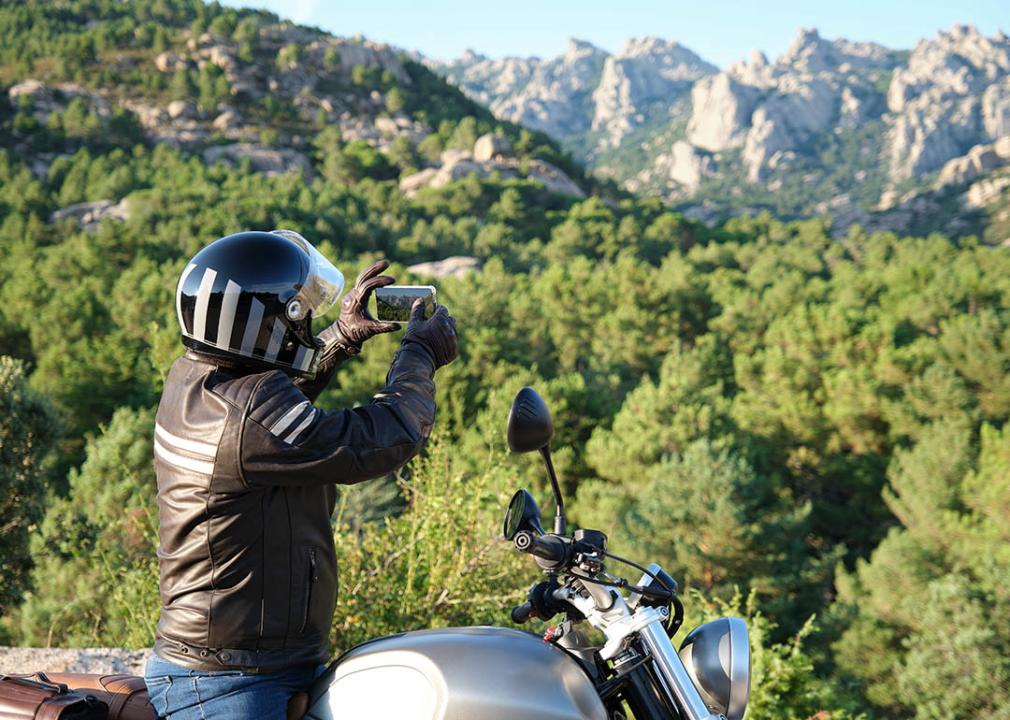
roberjzm // Shutterstock
5 can’t-miss motorcycle road trips
motorcyclist taking photos of scenery by side of the road, mountains and greenery
Motorcycling is a great way to experience some of the most beautiful scenery in the world. Cheap Insurance takes a look at five motorcycle road trips that provide a look at America’s history, scenery, and freedom on the road. If you’re looking for an unforgettable adventure, consider taking one of these can’t-miss motorcycle road trips.
Key takeaways
- Choose the right motorcycle for your trip. Consider the length of your trip, the type of terrain you’ll be riding on, and your own riding experience when choosing a motorcycle.
- Plan your route carefully. Make sure to factor in the distance, weather conditions, and road closures when planning your route.
- Pack light. You’ll want to pack light so that you don’t weigh your motorcycle down too much.
- Take breaks often. Get off your motorcycle and stretch your legs every two hours or so.
- Be aware of your surroundings. Be sure to watch out for other vehicles, animals, and road hazards.
![]()
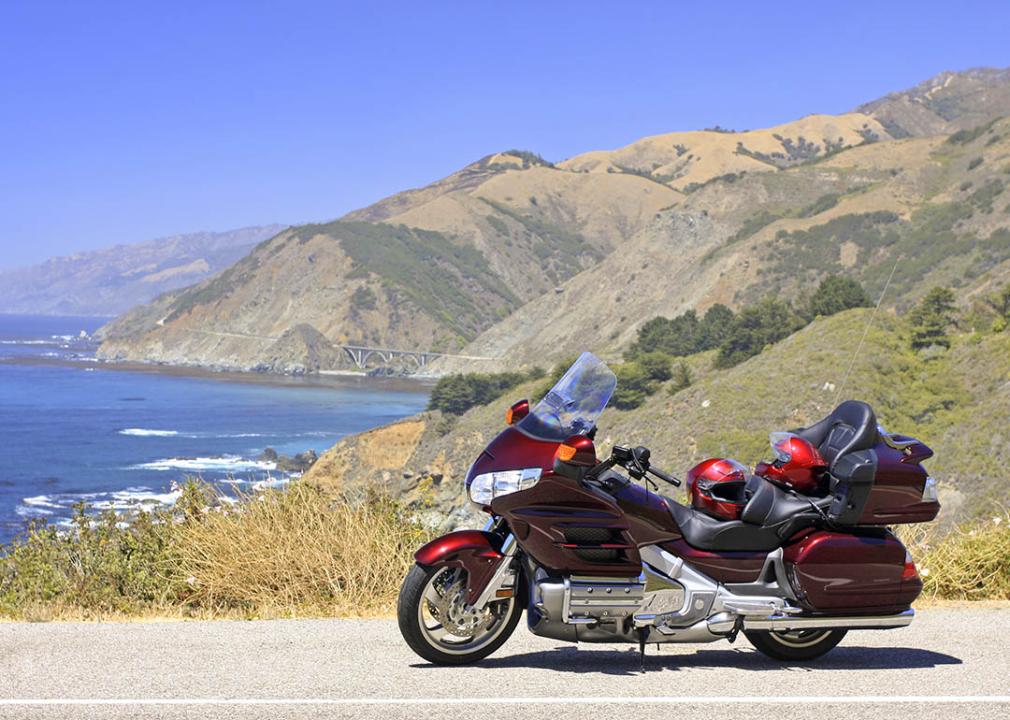
Vlad G // Shutterstock
Number 1: Pacific Coast Highway, California
motorcycle parked next to the ocean in Big Sur
This iconic highway stretches for over 600 miles along the California coast, from San Diego to Crescent City. The scenery is breathtaking, with stunning ocean views, rugged cliffs, and rolling hills. You’ll also pass through some of the most charming towns in California, such as Carmel-by-the-Sea and Santa Barbara.
A historical overview
The Pacific Coast Highway, fondly known as PCH or Highway One, is an iconic American road trip destination, winding its way along the breathtaking California coastline for over 600 miles. Its origins can be traced back to the early 1900s, when a series of local roads along the coast were gradually connected to form a continuous route. In 1929, the highway was officially named the Roosevelt Highway in honor of President Theodore Roosevelt, an avid outdoorsman and proponent of road development.
A motorcyclist’s paradise
For motorcyclists seeking an unforgettable adventure, the Pacific Coast Highway offers a mesmerizing blend of scenic wonders and cultural gems. The highway hugs the coastline, offering panoramic views of the Pacific Ocean, rugged cliffs, and charming coastal towns. The route is dotted with viewpoints, parks, and historical landmarks, providing ample opportunities to stretch your legs, refuel, and immerse yourself in the rich heritage of the region.
Popular stops and sights
- Hearst Castle: Nestled amidst the rugged cliffs of San Simeon, this opulent estate built by newspaper magnate William Randolph Hearst offers a glimpse into the extravagant lifestyle of the Gilded Age.
- Nepenthe: Perched on a cliff overlooking the ocean, this iconic restaurant is renowned for its breathtaking views and its Ambrosia burger, a local legend.
- McWay Falls: A hidden gem tucked away in Julia Pfeiffer Burns State Park, this 80-foot waterfall cascades directly onto the beach, creating a picture-perfect scene.
- Point Reyes National Seashore: This expansive coastal wilderness offers a diverse landscape of beaches, forests, and wildlife, providing opportunities for hiking, kayaking, and wildlife viewing.
- Santa Monica Pier: This iconic pier, known for its Ferris wheel, amusement park rides, and arcade games, offers a lively and entertaining atmosphere.
- Carmel-by-the-Sea: This charming town, nestled between the ocean and the Santa Lucia Mountains, boasts European-inspired architecture, art galleries, and boutique shops.
- Malibu: Renowned for its stunning beaches, celebrity homes, and upscale boutiques, Malibu embodies the epitome of California’s coastal allure.
- Zuma Beach: This expansive stretch of sandy beach offers opportunities for surfing, sunbathing, and enjoying the laid-back beach vibe.
- Point Mugu State Park: This park offers hiking trails, tide pools, and a visitor center with exhibits on local marine life.
- Ventura Harbor: A picturesque harbor with a variety of restaurants, shops, and boat tours, providing a relaxing ambiance and stunning views of the coastline.
Planning your motorcycle adventure
To fully appreciate the Pacific Coast Highway’s splendor, careful planning is essential. Consider the time of year, as fog can sometimes obscure coastal views. Pack appropriate clothing and gear for varying weather conditions. Familiarize yourself with the route and plan for stops along the way, including fuel, rest, and sightseeing. Most importantly, embrace the spirit of adventure and enjoy the journey!

Dee Browning // Shutterstock.
Number 2: Blue Ridge Parkway, North Carolina and Virginia
four motorcycle riders traveling on the blue ridge parkway
This scenic route winds its way through the Blue Ridge Mountains, offering stunning views of the Appalachian Mountains. The parkway is home to a variety of waterfalls, forests, and overlooks. You’ll also find plenty of opportunities to stop and hike, fish, or just enjoy the scenery.
The Blue Ridge Parkway, a ribbon of road meandering through the heart of the Appalachian Mountains, is more than just a scenic route; it’s a chronicle of history, a sanctuary of nature, and a haven for motorcyclists seeking an unforgettable adventure. Stretching over 469 miles from Shenandoah National Park in Virginia to Great Smoky Mountains National Park in North Carolina, the Blue Ridge Parkway invites travelers to immerse themselves in the beauty and tranquility of the Appalachian highlands.
A tapestry of history and nature
Conceived during the Great Depression as part of President Franklin D. Roosevelt’s New Deal, the Blue Ridge Parkway’s construction began in 1935. Over the next half-century, thousands of workers, guided by a vision of harmony between road and landscape, meticulously crafted this scenic highway. Today, the Blue Ridge Parkway stands as a testament to human ingenuity and a dedication to preserving the natural wonders of the Appalachian region.
A motorcyclist’s dream ride
For motorcyclists, the Blue Ridge Parkway offers an unparalleled riding experience. The parkway’s gentle curves and moderate speed limits allow riders to fully appreciate the breathtaking scenery that unfolds before them. Winding through forests, past waterfalls, and over mountain ridges, the Blue Ridge Parkway provides a continuous panorama of natural beauty.
Popular stops and sights for motorcyclists
Along the Blue Ridge Parkway, numerous stops and attractions invite motorcyclists to pause and savor the moment. From historic sites to scenic overlooks, the parkway offers a wealth of experiences to enrich any motorcycle journey.
- Mabry Mill: Step back in time at Mabry Mill, a restored 18th-century gristmill nestled in the foothills of the Blue Ridge Mountains. Watch as the waterwheel turns, grinding grain into flour, and immerse yourself in the mill’s tranquil setting.
- Linn Cove Viaduct: Marvel at the engineering marvel of the Linn Cove Viaduct, a winding bridge seamlessly integrated into the mountainside. As you ride across this remarkable structure, take in the breathtaking views of the surrounding forest.
- Moses H. Cone Memorial Park: Escape the hustle and bustle at Moses H. Cone Memorial Park, a sprawling estate with stunning views of the Blue Ridge Mountains. Explore the park’s gardens, hike its trails, or simply relax and enjoy the serenity of the surroundings.
- Grandfather Mountain: Ascend to the summit of Grandfather Mountain, the highest peak on the Blue Ridge Parkway, and witness breathtaking panoramic views of the surrounding landscape. Hike to the top or take the Grandfather Mountain Scenic Railway for an unforgettable journey.
- Folk Art Center: Discover the rich cultural heritage of Appalachia at the Folk Art Center, a treasure trove of handcrafted artifacts, paintings, and quilts. Immerse yourself in the region’s traditions and appreciate the artistry of local artisans.
The Blue Ridge Parkway, with its captivating blend of history, nature, and cultural heritage, offers motorcyclists an unparalleled journey through the heart of the Appalachian Mountains. As you navigate the parkway’s winding roads, let the tranquility of the surroundings wash over you, and savor the memories you create along this unforgettable route.
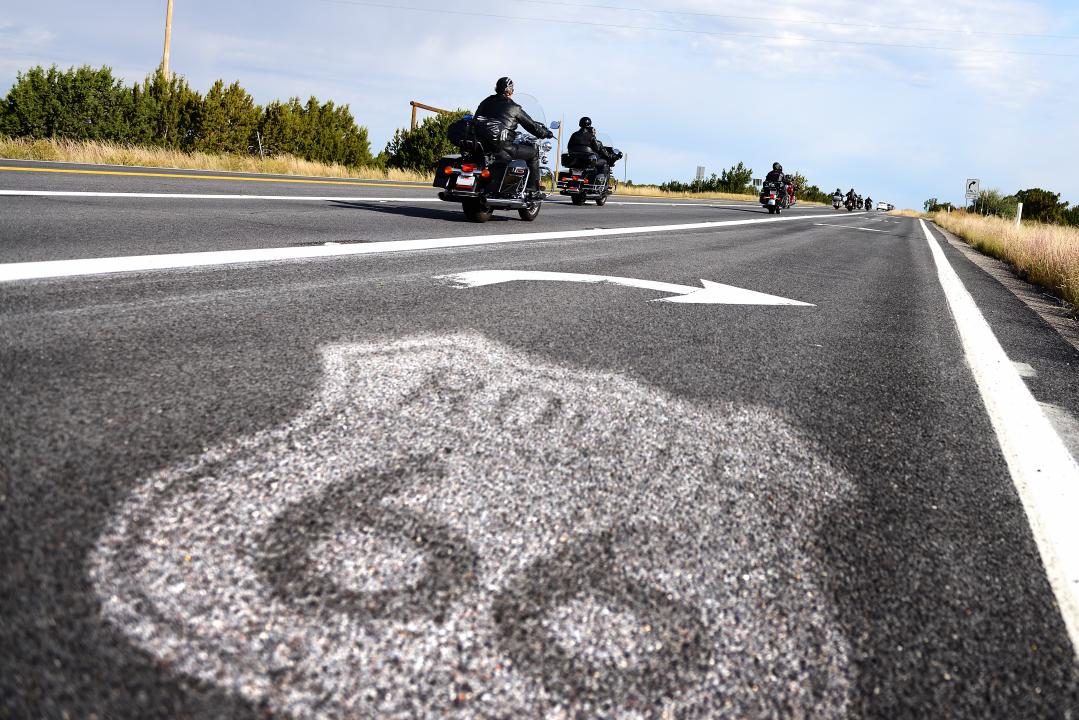
ventdusud // Shutterstock
Number 3: Route 66
motorcyclists on route 66 in Arizona
This historic highway was once known as the “Main Street of America.” Route 66 runs from Chicago to Los Angeles, passing through eight states along the way. The route is lined with diners, motels, and other roadside attractions that will give you a taste of Americana.
Route 66, also known as the “Will Rogers Highway,” is an iconic road that has captured the imagination of travelers and motorcyclists for generations. Stretching over 2,400 miles from Chicago, Illinois, to Santa Monica, California, Route 66 has served as a lifeline for countless Americans, connecting communities, fostering commerce, and shaping the nation’s identity. Since Route 66 crosses multiple states, riders should be aware of state-specific laws and requirements, such as mandatory helmet laws, and motorcycle insurance.
A road borne of necessity
In the early 20th century, as the automobile revolutionized transportation, the need for a transcontinental highway became increasingly evident. In 1926, Route 66 was officially designated, linking the Midwest to the West Coast and providing a vital passage for families seeking new opportunities during the Great Depression.
A symbol of the American Dream
Route 66 quickly became more than just a road; it became a symbol of the American Dream, a representation of freedom, adventure, and the boundless possibilities that lay beyond the horizon. Diners, motels, and roadside attractions sprang up along the route, catering to the needs of weary travelers and capturing the essence of Americana.
A haven for motorcyclists
For motorcyclists, Route 66 holds a special allure. The road’s winding paths, historic landmarks, and nostalgic atmosphere provide an unparalleled riding experience. Whether it’s cruising through the desert landscapes of Arizona or traversing the mountains of New Mexico, Route 66 offers a journey filled with discovery and adventure.
Popular stops and sights for motorcyclists
Along the legendary Route 66, numerous stops and attractions beckon motorcyclists to pause, explore, and immerse themselves in the rich history and culture that define this iconic road.
- The Blue Whale of Catoosa: This quirky roadside attraction in Catoosa, Oklahoma, is a whimsical testament to Route 66’s kitschy charm. The giant blue whale, perched atop a former oil well, is a popular stop for photo ops and souvenirs.
- Cadillac Ranch: Just outside Amarillo, Texas, the Cadillac Ranch stands as a unique monument to American pop culture. Ten Cadillacs, buried nose-down in the ground, create a striking visual spectacle, symbolizing the end of an era and the changing landscape of America.
- Route 66 Midpoint: In Tucumcari, New Mexico, celebrate your halfway point on Route 66 at the aptly named Midpoint Cafe. Enjoy a classic diner meal and soak in the atmosphere of a true Route 66 establishment.
- Wigwam Village Motel: Step back in time at the Wigwam Village Motel in Holbrook, Arizona. Nestled amidst the desert landscape, this iconic motel features teepee-shaped cabins, offering a unique and nostalgic lodging experience.
- Santa Monica Pier: Mark your journey’s end at the Santa Monica Pier in California. Enjoy the carnival atmosphere, stroll along the beach, and take a photo with the iconic Route 66 End sign, commemorating the completion of your unforgettable adventure.
Route 66, with its rich history, cultural significance, and scenic beauty, continues to inspire and captivate travelers, especially motorcyclists. As you navigate the road’s twists and turns, embrace the spirit of adventure, savor the nostalgia, and create lasting memories along this legendary American highway.
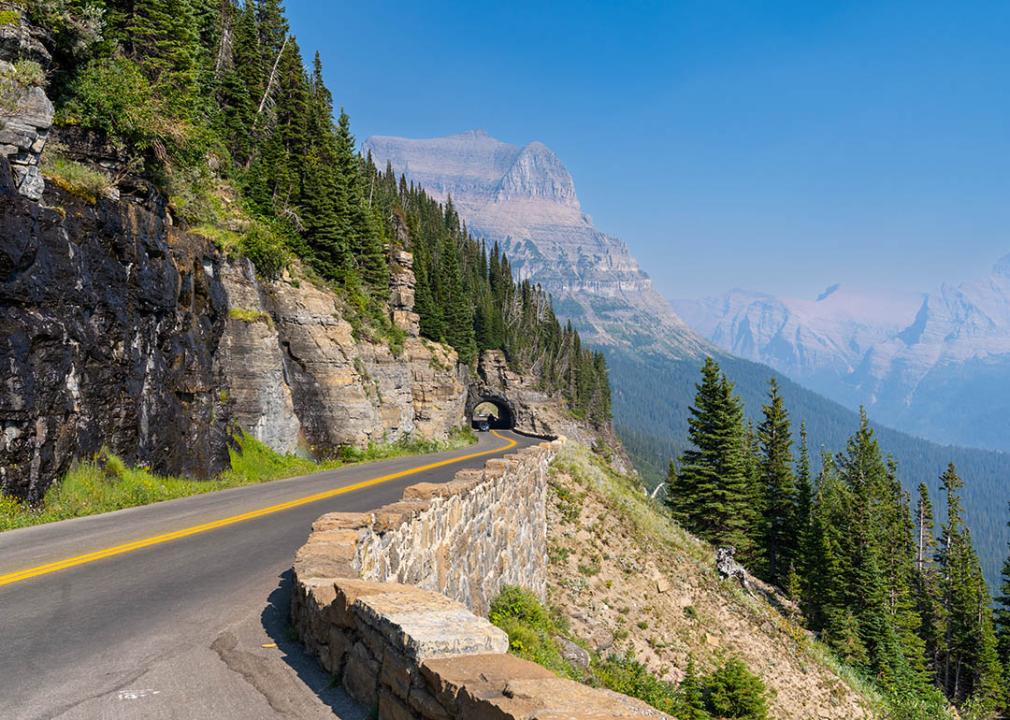
melissamn // Shutterstock
Number 4: Going-to-the-Sun Road, Glacier National Park, Montana
view of going-to-the-sun road from a pullout
This spectacular road winds its way through Glacier National Park, offering stunning views of the Rocky Mountains. The road is only open for a few months each year, so be sure to plan your trip accordingly.
Nestled within the awe-inspiring embrace of Glacier National Park in Montana lies the Going-to-the-Sun Road, a 50-mile masterpiece of engineering that winds its way through the park’s breathtaking landscapes. As you navigate this serpentine route, you’ll be transported to a world of towering peaks, emerald lakes, and cascading waterfalls, all framed by the grandeur of the Rocky Mountains.
A road borne of vision
The Going-to-the-Sun Road’s origins can be traced to the early 20th century, when visionary park superintendent Stephen Mather recognized the need for a road that would unveil Glacier National Park’s hidden gems to the public. Construction began in 1921, and over the next two decades, workers painstakingly carved the road out of the mountainside, guided by a deep respect for the park’s natural beauty.
A season of splendor
Due to its high elevation and susceptibility to snowpack, the Going-to-the-Sun Road is typically open only from late June to early October, making it a coveted destination for motorcyclists seeking an exhilarating ride amidst breathtaking scenery. As you traverse the road’s hairpin turns and ascend to its highest point, Logan Pass, you’ll be rewarded with panoramic vistas that will leave you breathless.
Popular stops and sights for motorcyclists
Along the Going-to-the-Sun Road, numerous stops and sights await motorcyclists, offering opportunities to immerse themselves in the park’s natural wonders and rich history.
- Jackson Glacier Overlook: Witness the grandeur of Jackson Glacier, a remnant of the Ice Age, from the Jackson Glacier Overlook. Take in the glacier’s imposing presence as it descends into the valley below.
- St. Mary Lake: Stroll along the shores of St. Mary Lake, a serene body of water reflecting the towering peaks of the surrounding mountains. Rent a boat and explore the lake’s tranquil waters or simply relax and soak in the tranquil atmosphere.
- McDonald Falls: Take a refreshing break at McDonald Falls, a cascading waterfall that plunges into a picturesque pool. Hike to the top of the falls or enjoy the scenic views from the viewing platform.
- Logan Pass: At the summit of Going-to-the-Sun Road, Logan Pass offers panoramic views of the Continental Divide and the surrounding mountain peaks. Hike to the summit of Clements Mountain for even more breathtaking vistas.
- Sun Point: Ascend to Sun Point, a scenic overlook that provides stunning views of the Garden Wall, a sheer rock face that rises dramatically from the valley below. Take a moment to appreciate the geological forces that shaped this awe-inspiring landscape.
The Going-to-the-Sun Road, with its winding paths, breathtaking vistas, and rich history, is a must-do for any motorcyclist seeking an unforgettable adventure. As you navigate this iconic route, be mindful of the park’s wildlife, respect its natural beauty, and create memories that will last a lifetime.
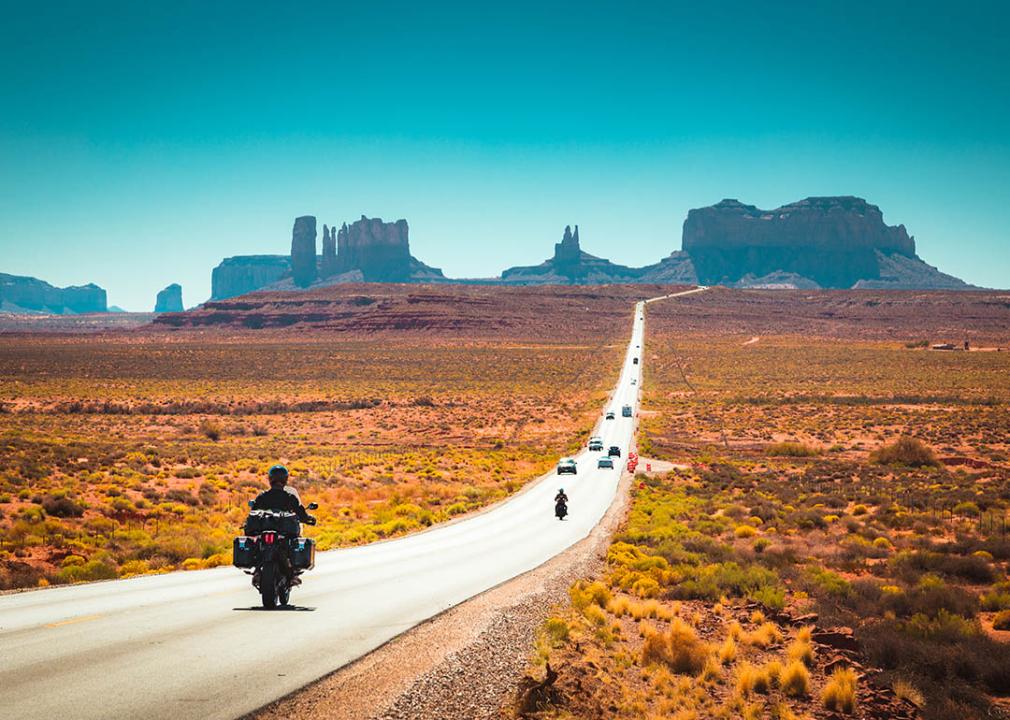
Canadastock // Shutterstock
Number 5: Grand Circle Road, Utah
Classic panorama view of motorcyclist on road in moab headed toward monument valley
This loop road takes you through some of the most spectacular scenery in the Southwest, including Arches National Park, Bryce Canyon National Park, and Zion National Park. The road is also home to a variety of small towns and historical sites.
The Grand Circle Road is a scenic loop road that takes you through some of the most spectacular scenery in the Southwest. The road was originally established in the early 1900s as a way to connect several national parks in the region. Over the years, the road has become increasingly popular with tourists and motorcyclists alike.
Popular stops and sights
The Grand Circle Road is home to a variety of popular stops and sights, including:
- Arches National Park: Arches National Park is home to over 2,000 natural sandstone arches, making it the largest concentration of arches in the world.
- Bryce Canyon National Park: Bryce Canyon National Park is known for its hoodoos, which are tall, thin rock spires that have been eroded over millions of years.
- Canyonlands National Park: Canyonlands National Park is divided into three districts: The Needles, The Maze, and Island in the Sky. Each district offers its own unique scenery and hiking trails.
- Capitol Reef National Park: Capitol Reef National Park is home to a variety of geological features, including Waterpocket Fold, a 100-mile-long wrinkle in the Earth’s crust.
- Zion National Park: Zion National Park is known for its towering cliffs, narrow canyons, and emerald green pools.
In addition to these national parks, the Grand Circle Road also passes through a number of small towns and historical sites. These include:
- Moab, Utah: Moab is a popular destination for mountain biking, rock climbing, and off-roading.
- Monument Valley: Monument Valley is known for its otherworldly landscape of sandstone buttes and mesas.
- Natural Bridges National Monument: Natural Bridges National Monument is home to three large natural bridges, including Sipapu Bridge, which is the largest natural bridge in the span in the United States.
- Rainbow Point: Rainbow Point offers stunning views of the Colorado River and the Painted Desert.
Tips for motorcyclists
The Grand Circle Road is a great route for motorcyclists. However, there are a few things to keep in mind:
- The road can be windy in some sections, so be sure to take your time and ride cautiously.
- The weather can change quickly in the mountains, so be sure to pack for all types of conditions.
- There are a number of wildlife crossings along the road, so be sure to watch for animals.
Overall, the Grand Circle Road is a must-do for any motorcyclist who is looking for an unforgettable adventure. With its stunning scenery, variety of stops and sights, and challenging terrain, the road is sure to please riders of any experience level.
Tips for planning your motorcycle road trip
- Choose the right motorcycle for your trip. Consider the length of your trip, the type of terrain you’ll be riding on, and your own riding experience when choosing a motorcycle.
- Make sure that you are protected – affordable motorcycle insurance coverage can protect you and your property from the unexpected.
- Plan your route carefully. Make sure to factor in the distance, weather conditions, and road closures when planning your route.
- Pack light. You’ll want to pack light so that you don’t weigh your motorcycle down too much.
- Take breaks often. Get off your motorcycle and stretch your legs every two hours or so.
- Be aware of your surroundings. Be sure to watch out for other vehicles, animals, and road hazards.
- Enjoy the ride! Motorcycle road trips are a great way to relax, de-stress, and see some of the most beautiful scenery in the world.
With a little planning, you can have an unforgettable motorcycle road trip experience. So get out there and explore!
This story was produced by CheapInsurance.com and reviewed and distributed by Stacker Media.
